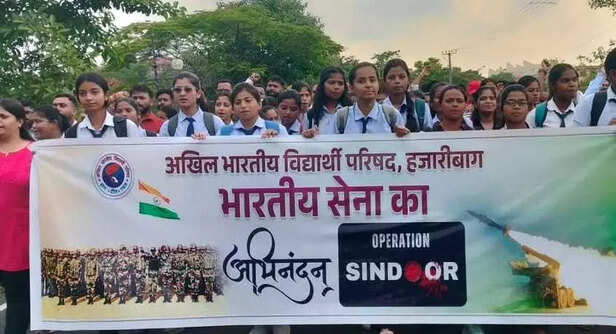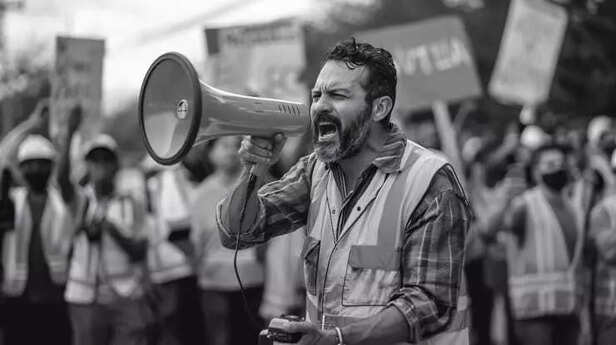India Strikes with Valor—A Billion Voices Echo Jai Hind!
Prem Kamde | Fri, 09 May 2025
In a bold and decisive move, India launched a strategic strike against Pakistan, igniting a wave of powerful emotions across the nation. From city streets to remote villages, the air buzzed with patriotic fervor, anxiety, and unity. Citizens hailed the bravery of the armed forces, flooding social media with support and national pride. As tensions surged, so did solidarity—temples, homes, and schools resounded with chants of "Jai Hind." While political and diplomatic arenas braced for repercussions, the people of India stood resilient, proud, and emotionally charged. This was more than a military maneuver; it was a national moment of reckoning, reflection, and roaring unity.
A Billion Voices Echo Jai Hind!
( Image credit : Freepik )
India and Pakistan have always shared a tense and often hostile relationship. From wars to cross-border skirmishes and terrorist attacks, the two nations have had many conflicts since their partition in 1947. In recent years, whenever India has responded with military action—such as a surgical strike or airstrike—the country has witnessed an intense emotional and patriotic reaction from its citizens.
This article explores the reactions of the Indian public when India responds militarily to aggression from Pakistan, and how such actions shape the national mood.

India does not take military action lightly. When it does so, it is usually after a major provocation – often a terrorist attack on Indian soil linked to Pakistan-based groups. The most notable example was the Pulwama attack in February 2019, in which more than 40 CRPF jawans were killed. In response, the Indian Air Force carried out a precision airstrike on terrorist training camps in Balakot, Pakistan.
And after the recent Pahalgam attack that killed 27 people, Indian military forces have recently struck nine terrorist camps in Pakistan, killing more than 100 terrorists.
Such decisions are taken at the highest levels of government and military command. They are aimed not only at eliminating threats, but also sending a strong message: India will not tolerate terrorism or proxy war.

Whenever India strikes back, the streets of the country reflect a wide range of emotions—from pride and unity to concern and anxiety.
In cities and towns, people chant slogans like “Bharat Mata Ki Jai” and “Jai Hind.” Social media platforms flood with messages of support for the armed forces. Hashtags like #IndiaStrikesBack and #JaiHind trend instantly. Television news channels run continuous coverage, analyzing every detail of the strike and replaying expert opinions.
This time too, after Operation Sindoor of the armed forces, there is a wave of enthusiasm among the people. People are praising their Indian Army. #Operation Sindoor is trending on all social media platforms.
At the same time, there is also a sense of fear and uncertainty. Will this lead to war? Will there be retaliation? Many families worry about loved ones in the armed forces stationed near the borders. While patriotism soars, so does the silent prayer for peace.

In moments like these, political divisions tend to blur. People from different backgrounds come together in support of the nation. Students, business owners, farmers, celebrities—all express admiration for the armed forces.
Schools conduct special assemblies. Offices organize moments of silence for fallen soldiers. Religious institutions hold prayers for national safety. In short, the nation comes together like a family under threat, showing both its pride and its pain.
Even those who criticize government policies or decisions generally express support for the soldiers and the defense forces. Nationalism runs deep in such moments, and unity becomes more visible than ever.

As of 2025, the situation between India and Pakistan remains tense but controlled. There has been no full-scale war, but occasional ceasefire violations and threats persist. India continues to focus on strengthening its defense, intelligence, and surveillance systems.
The Indian public, too, is more aware than ever. People now follow strategic issues closely, watch debates, and stay informed through digital media. Unlike before, where only experts spoke on national security, now even students and working professionals engage in such discussions.
Recent comments by defense officials and the modernization of Indian forces show that India is prepared not only to defend itself but also to act if provoked. The most recent example of this is Operation Sindoor. This robust stance gives reassurance to the public, even though the possibility of conflict always looms in the background.

While there is always loud support when India takes military action, there is also a deep desire for lasting peace. People do not want war. They want safety, development, and stability. The youth of both countries dream of progress, not bullets. However, peace must come with security. India’s people trust that if aggression rises, the country will respond with strength and dignity.
Everyone is chanting Jai Hind to encourage the people after Operation Sindoor. This is the highest trending trend on social media. From celebrities to big politicians, everyone is using it. Every slogan of "Jai Hind" is a salute to the brave and a hope for a peaceful tomorrow.
India’s strikes against threats from across the border are not just military events—they are emotional moments for the entire nation. They awaken patriotism, unity, and often grief. Whether it’s lighting candles for martyrs, waving the tricolor from rooftops, or simply standing still during the national anthem, these moments show what India truly is—a country that stands tall in pain, pride, and purpose.
And when India strikes with valor, indeed, a billion voices echo... “Jai Hind!”
Unlock insightful tips and inspiration on personal growth, productivity, and well-being. Stay motivated and updated with the latest at My Life XP.
This article explores the reactions of the Indian public when India responds militarily to aggression from Pakistan, and how such actions shape the national mood.
The Trigger Behind the Strikes

Terrorists attack helpless people
( Image credit : Freepik )
India does not take military action lightly. When it does so, it is usually after a major provocation – often a terrorist attack on Indian soil linked to Pakistan-based groups. The most notable example was the Pulwama attack in February 2019, in which more than 40 CRPF jawans were killed. In response, the Indian Air Force carried out a precision airstrike on terrorist training camps in Balakot, Pakistan.
And after the recent Pahalgam attack that killed 27 people, Indian military forces have recently struck nine terrorist camps in Pakistan, killing more than 100 terrorists.
Such decisions are taken at the highest levels of government and military command. They are aimed not only at eliminating threats, but also sending a strong message: India will not tolerate terrorism or proxy war.
Public Reaction: A Mix of Emotions

reaction from citizens.
( Image credit : Freepik )
Whenever India strikes back, the streets of the country reflect a wide range of emotions—from pride and unity to concern and anxiety.
In cities and towns, people chant slogans like “Bharat Mata Ki Jai” and “Jai Hind.” Social media platforms flood with messages of support for the armed forces. Hashtags like #IndiaStrikesBack and #JaiHind trend instantly. Television news channels run continuous coverage, analyzing every detail of the strike and replaying expert opinions.
This time too, after Operation Sindoor of the armed forces, there is a wave of enthusiasm among the people. People are praising their Indian Army. #Operation Sindoor is trending on all social media platforms.
At the same time, there is also a sense of fear and uncertainty. Will this lead to war? Will there be retaliation? Many families worry about loved ones in the armed forces stationed near the borders. While patriotism soars, so does the silent prayer for peace.
Unity and Nationalism in Full Force

Unity
( Image credit : Freepik )
In moments like these, political divisions tend to blur. People from different backgrounds come together in support of the nation. Students, business owners, farmers, celebrities—all express admiration for the armed forces.
Schools conduct special assemblies. Offices organize moments of silence for fallen soldiers. Religious institutions hold prayers for national safety. In short, the nation comes together like a family under threat, showing both its pride and its pain.
Even those who criticize government policies or decisions generally express support for the soldiers and the defense forces. Nationalism runs deep in such moments, and unity becomes more visible than ever.
Current Scenario: Tension and Readiness

Tension
( Image credit : Freepik )
As of 2025, the situation between India and Pakistan remains tense but controlled. There has been no full-scale war, but occasional ceasefire violations and threats persist. India continues to focus on strengthening its defense, intelligence, and surveillance systems.
The Indian public, too, is more aware than ever. People now follow strategic issues closely, watch debates, and stay informed through digital media. Unlike before, where only experts spoke on national security, now even students and working professionals engage in such discussions.
Recent comments by defense officials and the modernization of Indian forces show that India is prepared not only to defend itself but also to act if provoked. The most recent example of this is Operation Sindoor. This robust stance gives reassurance to the public, even though the possibility of conflict always looms in the background.
Looking Ahead: The Call for Peace

people called jai hind
( Image credit : Freepik )
While there is always loud support when India takes military action, there is also a deep desire for lasting peace. People do not want war. They want safety, development, and stability. The youth of both countries dream of progress, not bullets. However, peace must come with security. India’s people trust that if aggression rises, the country will respond with strength and dignity.
Everyone is chanting Jai Hind to encourage the people after Operation Sindoor. This is the highest trending trend on social media. From celebrities to big politicians, everyone is using it. Every slogan of "Jai Hind" is a salute to the brave and a hope for a peaceful tomorrow.
India’s strikes against threats from across the border are not just military events—they are emotional moments for the entire nation. They awaken patriotism, unity, and often grief. Whether it’s lighting candles for martyrs, waving the tricolor from rooftops, or simply standing still during the national anthem, these moments show what India truly is—a country that stands tall in pain, pride, and purpose.
And when India strikes with valor, indeed, a billion voices echo... “Jai Hind!”
Unlock insightful tips and inspiration on personal growth, productivity, and well-being. Stay motivated and updated with the latest at My Life XP.
Frequently asked questions (FAQs)-
- What does the phrase "India Strikes with Valor" refer to?
This phrase symbolizes India's courageous and decisive actions, often in the context of defense operations, diplomatic achievements, or national resilience. It reflects the nation’s strength, unity, and readiness to protect its sovereignty. - Why is the slogan "A Billion Voices Echo Jai Hind" significant?
"Jai Hind," meaning "Victory to India," is a patriotic chant that unites Indians across the world. When described as echoed by a billion voices, it emphasizes the collective spirit, pride, and unwavering support of India’s citizens during moments of national importance. - When is this phrase typically used or heard?
This phrase is often invoked during national celebrations, military victories, significant achievements, or in the wake of events where India's unity and bravery shine—such as Republic Day, Independence Day, or after successful defense operations.







